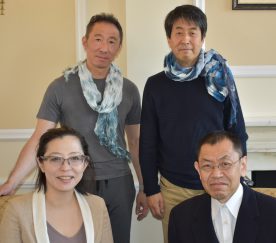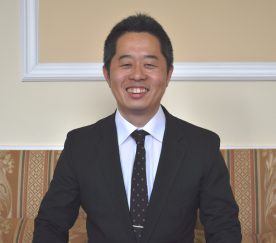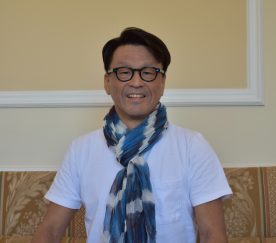 Special event
Special eventFriday 11 May 2018
10:30am – 4:30pm
Crafting Japan from Materials and Techniques: Hand Crafted Chrysanthemums
13/14 Cornwall Terrace, Outer Circle (entrance facing Regent's Park), London NW1 4QP
Organised by the Daiwa Anglo-Japanese Foundation
The ceramic chrysanthemum flower is one type of hand-crafted decorative element. Using a sharp-tipped bamboo tool, the shapes of the flower petals are cut out one-by-one from a lump of clay. Once the artist has a circle of petals, these are then carved in high relief. This process is repeated several times to create the chrysanthemum form which is attached to jars, plates and bottles as decoration. When carved, the individual petals stand up very sharply, but once the piece has been glazed and fired it softens to take on the appearance of a natural chrysanthemum.
During London Craft Week, Made in Japan Project and The Creation of Japan held a one-day crafting exhibition at the Daiwa Anglo-Japanese Foundation. The exhibition highlighted the variety of Japanese materials and techniques used to create hand-crafted pieces. Taiyo Nakazato, 18th generation potter of Hirado Kosho Danemon Kiln, demonstrated the techniques of Mikawachi ceramics, traditional porcelain with a 400 year old history. The porcelain was originally made by Korean masters brought to Japan, and originated in the Edo Period from Mikawachi, Nagasaki Prefecture.
The event was organised in a collaboration with London Craft Week.

About the contributors

The Creation of Japan
The Creation of Japan is a unique non-partisan organisation engaged in multi-disciplinary initiatives with the aim of preserving the “crafting beauty” of Japan for the next century. Looking ahead to 100 years’ time requires building a network of connections across different genres, encompassing everything from the art, culture, and fashion of Japan, to urban networks, writers’ associations, schools, craftspeople, and manufacturers of materials. Our name, “The Creation of Japan”, reflects our view that doing this will lead to the creation of a new Japan.
http://thecreationofjapan.or.jp/about

Taiyo Nakazato
Taiyo Nakazato was born in Mikawachi, Nagasaki Prefecture, graduating from the Ceramics Department of Saga Prefectural Arita Technical High School, and later from the Department of Social Welfare at Kyohei Junior College as a Certified Social Worker. He then pursued language studies in the USA, and trained in ceramics in the Netherlands. Now the 18th generation head of Hirado Kosho Danemon Kiln, he has won the Grand Prix at the Mikawachi Ceramics Exhibition, and the Traditional Industries Encouragement Award at the Nagasaki Ceramics Competition. Hirado Kosho Danemon Kiln has earned high praise in Europe, including from royal courts, and the works from the kiln are exhibited in museums including the British Museum and the V&A.

Arimastu Shibori-Some
Shibori is a resist dyeing technique in which patterns are created by tying, stitching, or binding the fabric and then dyeing it. Arimatsu Narumi shibori was first created around the 17th century. One of the most well-known methods used in shibori is tying a pattern into the fabric before dyeing. Many people are involved in the process of finishing a work of shibori. Each step in the process is an art in itself, performed by a skilled artisan.
The theme of this exhibition is “Shape of Light.” Shibori-zome uses two of the most primitive techniques – tying and dyeing – to seek light in a piece of fabric and manipulate it into an expressive shape.
These expressive works are born in the space between two and three dimensions. Shadows created by overlapping the transparent fabric, gradations of light at the edges of the dye … Shibori-zome transforms a piece of cloth into a “fabric of light,” imbuing it with fresh life.

SUKUMO Leather
Atelier “Sukomo Leather” in the district of Awa, near Kyoto, specialises inthe extraction of natural indigos that can be applied to wide range of leather materials.
The leaves of the indigo plants are first handpicked, dried and then fermented following the 600-year-old Japanese method. Leather materials are then dyed by hand, resulting in endless shades of blue with subtle finishes on wide variety of skins, from calf to crocodile.

Made in Japan Project
NPO made in Japan Project (MIJP) is the business association founded in 2006. It aims to connect designers, producers, stores and consumers so that they inherit Japanese craftsmanship together. MIJP creates value added content that makes the community motivated and spotlights members from producers to consumers. We believe that providing opportunities that connect consumers and producers encourages members to understand Japanese culture more deeply and leads us to cultivate human resources to inherit the craftsmanship.

Takano Chikko Co., Ltd
Takano Chikko is located in Nagaokakyo City, Kyoto, a famous district for producing quality bamboo products. Bamboo forests are taken care of by Takano Chikko staff: they cut and process the bamboo themselves in order to make various products. Craftsmen who have various specialist skills work at this atelier. These include skill sets such as Sashimono (joining), Urush (lacquering), Maki-e (gold-relief lacquering) and Take-kogei(bamboo craftsmanship). They make a wide variety of products, ranging from tea ceremony utensils to goods for daily use.